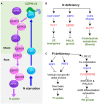Signaling Peptides Regulating Abiotic Stress Responses in Plants
- PMID: 34349774
- PMCID: PMC8326967
- DOI: 10.3389/fpls.2021.704490
Signaling Peptides Regulating Abiotic Stress Responses in Plants
Abstract
As sessile organisms, plants are exposed to constantly changing environments that are often stressful for their growth and development. To cope with these stresses, plants have evolved complex and sophisticated stress-responsive signaling pathways regulating the expression of transcription factors and biosynthesis of osmolytes that confer tolerance to plants. Signaling peptides acting like phytohormones control various aspects of plant growth and development via cell-cell communication networks. These peptides are typically recognized by membrane-embedded receptor-like kinases, inducing activation of cellular signaling to control plant growth and development. Recent studies have revealed that several signaling peptides play important roles in plant responses to abiotic stress. In this mini review, we provide recent findings on the roles and signaling pathways of peptides that are involved in coordinating plant responses to abiotic stresses, such as dehydration, high salinity, reactive oxygen species, and heat. We also discuss recent developments in signaling peptides that play a role in plant adaptation responses to nutrient deficiency stress, focusing on nitrogen and phosphate deficiency responses.
Keywords: dehydration; reactive oxygen species; receptor-like kinases; salt; signaling peptides.
Copyright © 2021 Kim, Jeon and Kim.
Conflict of interest statement
The authors declare that the research was conducted in the absence of any commercial or financial relationships that could be construed as a potential conflict of interest.
Figures


References
-
- Araya T., Miyamoto M., Wibowo J., Suzuki A., Kojima S., Tsuchiya Y. N., et al. (2014). CLE-CLAVATA1 peptide-receptor signaling module regulates the expansion of plant root systems in a nitrogen-dependent manner. Proc. Natl. Acad. Sci. U. S. A. 111 2029–2034. 10.1073/pnas.1319953111 - DOI - PMC - PubMed
-
- Butenko M. A., Patterson S. E., Grini P. E., Stenvik G. E., Amundsen S. S., Mandal A., et al. (2003). Inflorescence deficient in abscission controls floral organ abscission in Arabidopsis and identifies a novel family of putative ligands in plants. Plant Cell 15 2296–2307. 10.1105/tpc.014365 - DOI - PMC - PubMed
Publication types
LinkOut - more resources
Full Text Sources
Other Literature Sources
Research Materials

